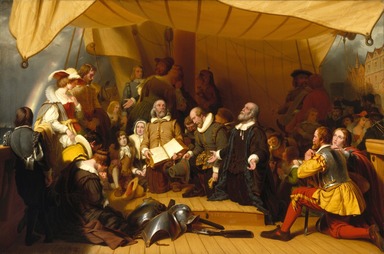In early 17th century England, the separatists who later became known as the Pilgrims were considered to be religious radicals, so dangerous that their beliefs earned some of them prison time.
What was so dangerous about their ideas? They wanted to start churches separate from the Church of England, which they believed was too steeped in Catholicism to be reformed. They sought to live their lives by the Word of God. The less radical Puritans contended that the Church of England needed purifying. Both groups longed for a return to the ways of the early Christians and believed that the Bible, not the traditions of men, was the final authority.
Facing persecution in England, a group of the Pilgrims sold their homes, farms, and businesses, and left the familiar behind to become refugees in the Netherlands. For almost twelve years, many of them, including the children, worked to scratch out a living in the textile industry in the unfamiliar land.
Concerned that their older children were becoming corrupted by the culture of their new country, and unable to return to England where their views would not be tolerated, they decided to sail to the New World to start afresh and carve out a future for their children. According to William Bradford, they also desired to spread the Gospel.
The community of believers contracted with investors in order to obtain passage and supplies for the trip. For seven years, their land and possessions would belong to the Merchant Adventurers Investor Group as the immigrants worked to pay off the debt.
The Saints, the term the Pilgrims used for themselves, initially embarked on the Speedwell, but after two failed attempts to fix a leakage problem and several wasted weeks, the passengers abandoned the Speedwell for its sister ship, the Mayflower, a commercial vessel the investors had secured for the journey. In the end, forty-one Pilgrims/Saints along with sixty-one Strangers (craftsmen and indentured servants who’d hired on for the journey) embarked on the blustery voyage that lasted sixty-six days. (This was after the Pilgrims had already spent about six weeks aboard ship.)
It was a 3,000 mile trip in a vessel designed to carry cargo like lumber and barrels, etc., not passengers. According to professional sailor, Conrad Humphreys, “The boat would have been rolling like a pig. The smell and stench of illness and sickness down below, and the freezing cold on deck in the elements, it would have been pretty miserable.”
The passengers were assigned to a 58 by 24 feet windowless area on the gun deck, with very little privacy. Tossed about in the stormy Atlantic, they survived on hardtack biscuits, dried meat, and beer. Occasionally, the crew would allow a passenger or two above deck for a breath of fresh air, but these respites were few and far between.
During one horrendous storm, a mast or mid-post cracked, and the passengers considered turning back, but they were able to secure the beam with a large iron screw. According to Bradford, they “committed themselves to the will of God and resolved to proceed.”
On November 11, 1620, when they, at last, came within sight of the New World, “They fell upon their knees and blessed the God of Heaven who had brought them over the vast and furious ocean, and delivered them from all the perils and miseries thereof, again to set their feet on the firm and stable earth, their proper element” (William Bradford in Of Plymouth Plantation).
It was Cape Cod, not the Hudson Bay as planned, and the land, as well as the inhabitants, was foreign and unknown. Their hardships were far from over, but they committed their future to God and rejoiced. Ordinary people, with extraordinary faith, and an unstoppable God.
Sources:
Bradford, William. Of Plymouth Plantation, 1651.
What Was Life Like Aboard the Mayflower? – HISTORY
Roos, David. “The Pilgrims Miserable of Journey Aboard the Mayflower” History Channel. 11/20/20.
Why Did the Pilgrims Come to America? – HISTORY
Klein, Christopher. “Why Did the Pilgrims Come to America.” History Channel. 10/13/20.


Thank you for this, Sherry!
It’s good to remember the gory details of our heritage.
Yes, such bravery and faith.:)
Yes, I was inspired by how much they went through in order to follow their faith. Our trials seem minor compared to theirs.
I wanted to understand what it was like to be on the Mayflower and what they gave up and went through in order to get here.
Thank you for this article, Sherry. Those Pilgrims were indeed a brave people. They had no idea what they’d face in the New World but were willing to come to its shores. A great article also for the coming season of Thanksgiving.
Thank you! Yes, they had tremendous courage. It’s hard for me to imagine risking so much with so much unknown. I believe their faith carried them through.